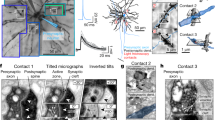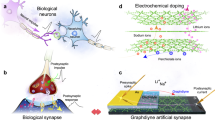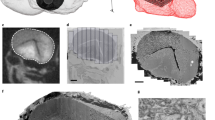Abstract
Electrical synapses provide a basis for efficient signal transmission in a wide variety of nervous systems1. These synapses are composed of specialized cell-to-cell contacts known as nexuses2 or gap junctions3 which mediate the direct transfer of ions and small molecules between adjacent cell interiors1,4 by way of intercellular channels embedded in the junctional membrane5. The crayfish giant motor synapse (CMS) was the first cell-to-cell junction clearly demonstrated to operate by an electrical mechanism6. Current applied to the presynaptic lateral giant (LG) axon or to the neurite of the postsynaptic giant flexor motoneurone (MoG) spreads passively through the synapse into the adjacent neurone6,7. Each GMS behaves like an electrical rectifier: its conductance is high when LG is positive with respect to MoG, and decreases dramatically when the sign of the trans-synaptic voltage is reversed6,7. We have now examined GMS conductance and dye permeability at thoracic and abdominal levels of the crayfish nerve cord. At both levels, values of GMS chord conductance fit a simple Boltzmann model in which the conductance of individual synaptic channels is assumed to be voltage dependent. Moreover, thoracic synapses display higher limiting conductances than do those at an abdominal level, apparently as a result of their larger size. We also find that synapses at both locations are permeable to the fluorescent dye Lucifer yellow, even in conditions where electrical conductance is low. These results provide a framework for understanding the operation and functional limits of rectifying electrical synapses, and illustrate that dye permeability can be associated even with their relatively low conductance condition.
This is a preview of subscription content, access via your institution
Access options
Subscribe to this journal
Receive 51 print issues and online access
$199.00 per year
only $3.90 per issue
Buy this article
- Purchase on Springer Link
- Instant access to full article PDF
Prices may be subject to local taxes which are calculated during checkout
Similar content being viewed by others
References
Bennet, M. V. L. in Handbook of Physiology, Sect. 1, 357–416 (Williams & Wilkins, Baltimore, 1977).
Dewey, M. M. & Barr, L. J. Cell Biol. 23, 553–585 (1964).
Revel, J. P. & Karnovsky, J. J. J. Cell Biol. 33, C7–C12 (1967).
Bennet, M. V. L. & Goodenough, D. A. Neurosci. Res. Prog. Bull. 16, 375–486 (1978).
Unwin, P. N. T. & Zampighi, G. Nature 283, 1–5 (1980).
Furshpan, E. J. & Potter, D. D. Nature 180, 342–343 (1957); J. Physiol., Lond. 145, 289–325 (1959).
Margiotta, J. thesis, State Univ. New York (1980).
Wine, J. J., Mittenthal, J. E. & Kennedy, D. J. comp. Physiol. 93, 315–335 (1974).
Stewart, W. Cell 14, 741–759 (1978).
Johnson, G. E. J. comp. Neurol. 36, 323–375 (1924).
Mittenthal, J. E. & Wine, J. J. Science 179, 182–184 (1973); J. comp. Neurol. 177, 311–334 (1978).
Hanna, R. B., Keeter, J. S. & Pappas, G. D. J. Cell Biol. 79, 764–773 (1978).
Spray, D. C., Harris, A. L. & Bennett, M. V. L. Science 204, 432–434 (1979); J. gen. Physiol. 17, 77–93 (1981).
Jack, J. J. B., Noble, D. & Tsien, R. W. Electrical Current Flow in Excitable Cells (Oxford University Press, 1975).
Ehrenstein, G. & Lecar, H. Q. Rev. Biophys. 10, 1–34 (1977).
Payton, B. W., Bennett, M. V. L. & Pappas, G. D. Science 166, 1642–1643 (1969).
Warner, A. E. & Lawrence, P. A. Nature 245, 47–49 (1973); Cell 28, 243–252 (1982).
Simpson, I., Rose, B. & Loewenstein, W. R. Science 195, 294–296 (1977).
Brink, P. R. & Dewey, M. M. J. gen. Physiol. 72, 67–86 (1978).
Keeter, J. S., Deschenes, M., Pappas, G. D. & Bennett, M. V. L. Biol. Bull. 147, 485–486 (1974).
Zimmerman, A. L. & Rose, B. Biophys. J. 41, 216a (1983).
Watanabe, A. & Grundfest, H. J. gen. Physiol. 45, 267–308 (1961).
Author information
Authors and Affiliations
Rights and permissions
About this article
Cite this article
Margiotta, J., Walcott, B. Conductance and dye permeability of a rectifying electrical synapse. Nature 305, 52–55 (1983). https://doi.org/10.1038/305052a0
Received:
Accepted:
Issue Date:
DOI: https://doi.org/10.1038/305052a0
This article is cited by
-
Gap junctions in excitable cells
Journal of Bioenergetics and Biomembranes (1996)
-
Postembryonic development of rectifying electrical synapses in crayfish: physiology
Journal of Neurocytology (1991)
-
The mechanism of rectification at the electrotonic motor giant synapse of the crayfish
Nature (1986)
Comments
By submitting a comment you agree to abide by our Terms and Community Guidelines. If you find something abusive or that does not comply with our terms or guidelines please flag it as inappropriate.



